B2B Content Strategy: The Ultimate Guide for Driving Growth
Written by David L Hicks – February 24th, 2025
An effective B2B content strategy is crucial to a B2B organization’s success. As 2025 rolls forward, content development and marketing will continue to shift dramatically towards using artificial intelligence, placing a stronger emphasis on personalization and implementing multi-channel distribution. Whether you’re a seasoned professional or a beginner, understanding how to craft and execute a powerful B2B content strategy has never been more critical for staying competitive and driving powerful business relationships.
This guide will walk you through the essential elements of a modern B2B content strategy, from leveraging data-driven insights to creating content that resonates with your audience. We’ll also explore proven frameworks, emerging trends, and practical techniques that will help improve growth and drive actual business results.
Table of Contents
ToggleWhat is a B2B Content Strategy?
A B2B content strategy is a marketing approach in which businesses develop and distribute valuable, relevant, consistent content geared toward other companies within their target industry. It is generally the same as a traditional content strategy, with the only primary difference being that the content is tied directly to businesses.
Understand the B2B Content Landscape
Before building a B2B content strategy, we must understand its critical aspects. Once you better understand these, you’ll be well on your way to developing one.
Understand the Current B2B Content Trends
In today’s landscape, long-form technical content is on the rise. Many organizations and solo bloggers use long-form content such as skyscrapers and pillar articles to increase their audience. Long-form content is popular because it gives your audience a complete understanding of a topic. Long-form content also helps end your reader’s search intent as it answers all their questions. Within the B2B marketing space, long-form content only trails short posts, videos, and case studies. Long-form content usage is at 69%.
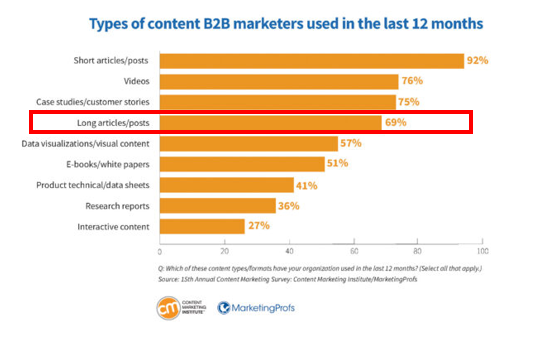
(Source – Content Marketing Institute)
The days of generating quick 1,000-word blog posts are slowly giving way to different types of content in the BB space. Written content is heading up to 1,500 words and up.
Understand Your Content in Relation to the B2B Industry
B2B content must address multiple stakeholders, generally about 6-8 decision-makers in a single purchase. Your content must speak to the technical folks while making sense to the C-suite (executives and corporate officers). Creating content clusters around core topics helps address these different perspectives effectively.

Before proceeding with your product or service, every decision-maker within the organization must agree. Your content acts as an introduction to your business and is also responsible for ensuring you retain customers. The better your content and the more it resonates with other organizations, the better your chances of getting new customers and keeping your existing ones.
Understand the Modern B2B Buyer’s Journey
The B2B buying journey has become seriously complex. B2B transactions emphasize building long-term relationships and trust. Your content should be designed to help speed up the buyer’s journey.
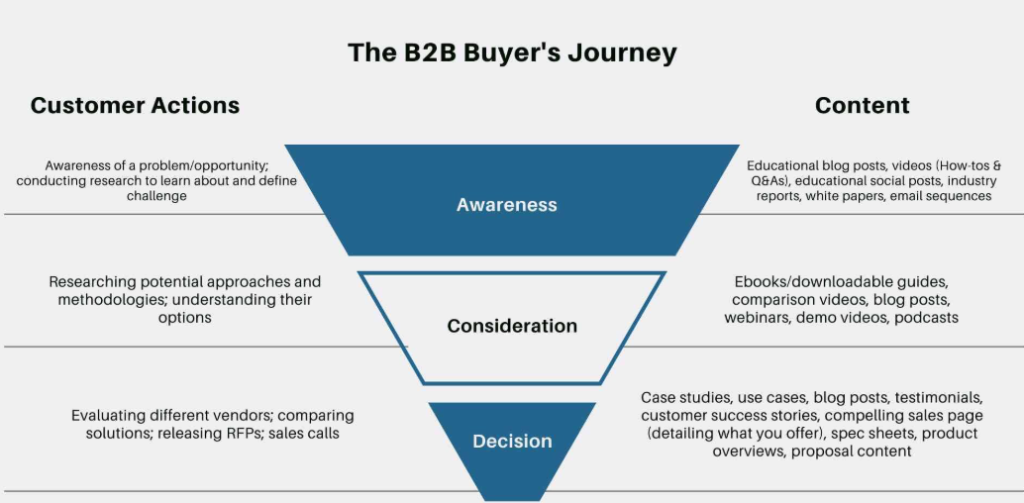
(Source – Utley Strategies)
I work in a corporation that involves many decision-makers, and I have seen firsthand the complexity of the decision-making process. I have been in meetings where we speak with 5-6 potential vendors before narrowing it down and eventually making the final decision. Before making each decision, many meetings occur. The better your content, the better your chances of speeding up the buying process.
Develop a Content Plan for Long Sales Cycles
Although your goal is to speed up the buying process, the unfortunate truth is that B2B sales cycles can stretch 12-18 months or longer. I’ve learned that successful content strategies need to play the long game. Breaking down your content into awareness, consideration, and decision stages isn’t just marketing theory; it’s vital for nurturing leads through these extended cycles.
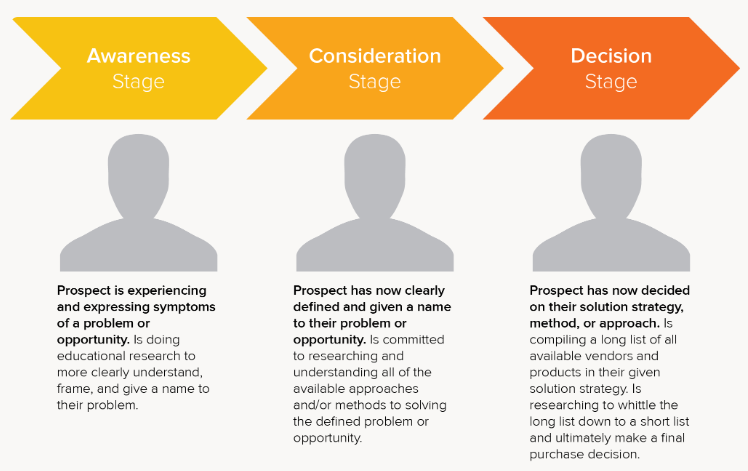
(Source – Velocity Media)
The most successful B2B content strategies balance educational value with strategic patience. For example, Ahrefs’ content ties back to its product. Ahrefs allows customers to use its keyword research platform. Their content consists of helpful educational content about their product, marketing, content development, and SEO. Below is an example of Ahref’s educational guide on keyword research.
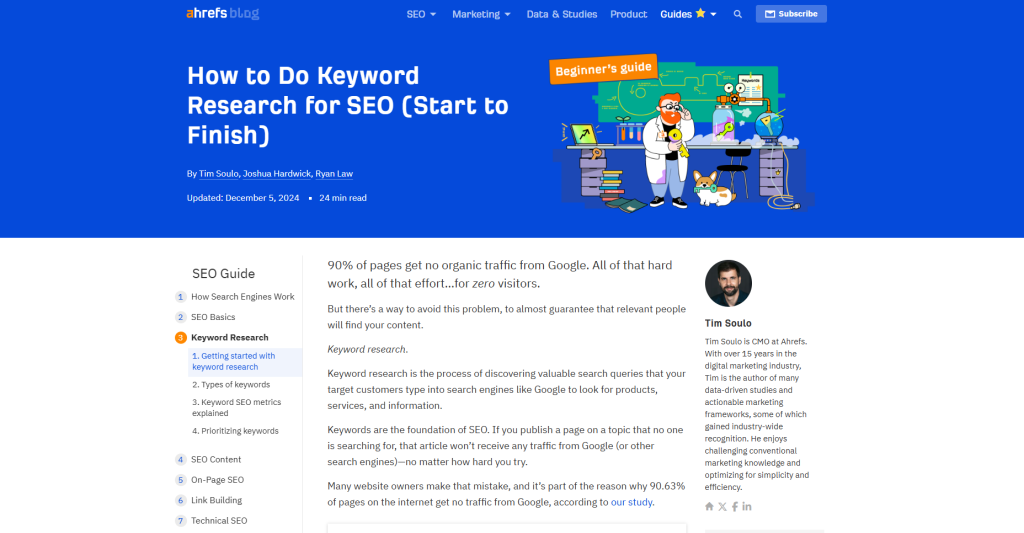
(Source – Ahrefs)
Develop Your B2B Content Strategy Foundation
Now that we understand the basics of the current B2B content environment, we can develop a B2B content strategy. Building a strong foundation for your B2B content strategy is vital because even the best content eventually fails without it. Decision-makers deal with information from countless sources; you must develop content that resonates with them all.
Build Multi-Stakeholder Buyer Personas
The first item on the list is building a buyer persona that covers multiple stakeholders within the same organization. Each purchase decision typically involves 6-8 stakeholders. Your content must address the IT manager’s technical concerns while addressing the CFO’s ROI questions.
Essential Persona Components
There are many components to a B2B persona. When developing yours, implement the following for starters:
- Daily pain points and challenges
- Role in the purchasing process
- Content consumption preferences
- Specific industry knowledge level
Below is an example of a high-level customer persona. A persona is excellent because it’s customizable.

Use the content strategy template, including a buyer persona chart, to help you build and customize your persona.
Build a Strategic Content Map
Random content creation just doesn’t cut it. Having random content can confuse readers because the various pieces of content that are developed aren’t aligned with each other. Content alignment is a critical aspect of the success of your B2B content strategy.
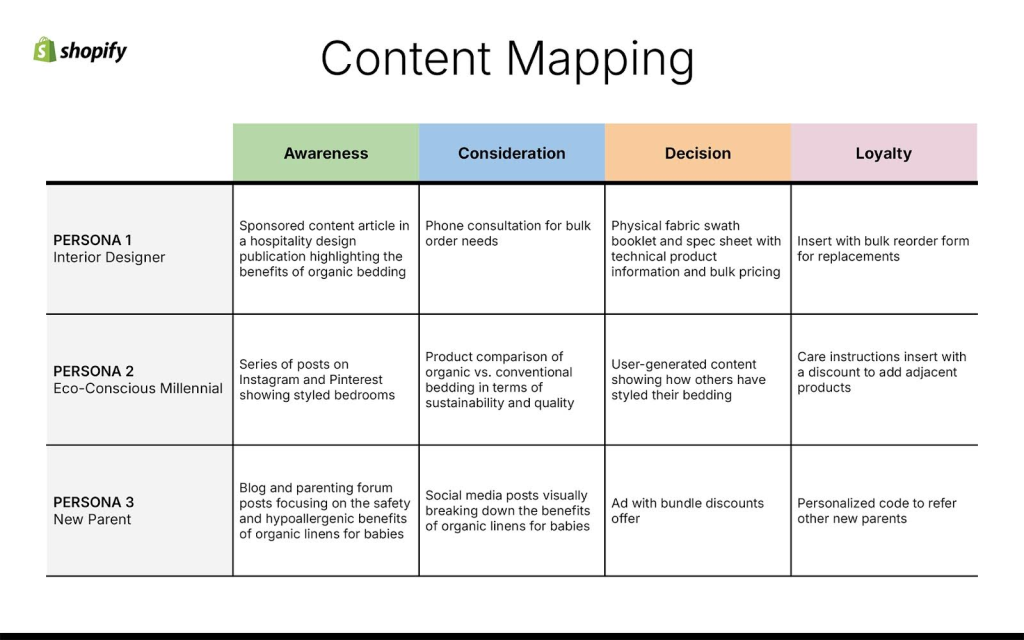
(Source – Shopify)
When mapping content to specific buying stages, use the 3-2-1 approach: three pieces of awareness content, two for consideration and one for decision-making. The 3-2-1 approach ensures your supporting prospects through every stage of their journey.
Develop SMART KPIs
Developing KPIs is vital to understanding whether your content performs according to your business goals. The development of SMART KPIs will help you reach those goals. A SMART KPI, by definition, is the same as a SMART goal.
- Specific – Well-defined and transparent regarding needs to be accomplished.
- Measurable – Enables you to analyze whether or not the goal was achieved.
- Attainable – Realistic as they pertain to what is possible, given the availability of resources, time, knowledge, and other relevant circumstances.
- Relevant – This is important to you and will significantly impact achieving your larger objectives.
- Time-Based – Locks goals to a specific timeframe, which will be completed by a given timeframe.
This approach to foundation-building might seem intense, but it’s worth every minute spent. SMART KPIs must also align with your business goals and objectives. If they don’t, they are aimless.
Create Various Types of High-Impact B2B Content
Although you may offer a specific service or product, B2B audiences may use it for different reasons. B2B audiences and key stakeholders have particular preferences. High-impact content must be developed to help resonate with the various parties in each organization. The more you can reach them, the higher your chances of success are. There are a couple of key high-impact quality types.
Develop True Thought Leadership within Your Content
Thought leadership involves sharing insightful, innovative, and authoritative perspectives on industry trends and topics. Demonstrating deep knowledge and experience within one’s industry is a goal that builds trust and credibility with one’s audience.
51% of C-Suite Executives say they spend more than 1 hour per week reading and reviewing thought leadership than ever before. This number has only grown since the survey was taken. Over time, more executives will examine these vital pieces of content.

(Source – LinkedIn)
Building thought leadership in your content will help you gain and retain the attention of the key decision-makers within your target audiences.
Create Technical Content
Technical content is also essential, especially when your product and or service is tech-based. Technical content, which includes how-to guides, statistics, metrics, and whitepapers, helps the technical managers and executives resonate with your content. When developing content like how-to guides and whitepapers, follow the 40-40-20 rule:
- 40% technical depth
- 40% business impact
- 20% actionable implementation steps
Implement Email Nurture Sequences
Progressive value disclosure is a vital key to effective B2B email nurturing. The most successful sequences deliver increasingly detailed informational content while connecting to business outcomes.
As part of your email sequencing process, you can provide various types of informational content, including how-to guides, statistics, metrics, and whitepapers. You can also offer discounts on products and services and free giveaways to entice audience members down the sales funnel.
Create Engaging Webinars
Audiences enjoy having webinars that are engaging and thought-provoking. The webinars that consistently pull attendance rates into programs combine three crucial elements:
- Technical deep-dives
- Live problem-solving segments
- Real customer success stories
Your webinar content should create an experience that feels more like a consulting session than a presentation. Consultations feel more personal and intimate to the audience.
Remember, high-impact B2B content isn’t just about the format; it’s about delivering genuine value that helps your audience make better decisions. That’s what differentiates content that merely exists from content that drives business results.
Implement Content Distribution and Amplification Strategies
Content distribution is distributing your content across various platforms, whether from your platforms (your website) or other platforms, including social media sites and other websites belonging to different organizations and bloggers in your industry. As a result, it should not be treated as an afterthought. To be successful with this endeavor, you should develop a content distribution plan.
Leverage LinkedIn Into Your Distribution Plan
With so many social media sites to distribute your content, it can be challenging to decide where to start. One website that B2B companies should use is LinkedIn. LinkedIn is a business and leadership-based social media site. B2B posts sharing technical insights with personal angles, white papers, and blog posts can help provide other organizations with insight into your organization.
Build a B2B Social Media Framework
A B2B social media framework acts as a roadmap for the content you should develop for the social media platforms you’ll be leveraging. One popular technique is the 3-2-1 rule. The 3-2-1 rule provides an ideal content balance that keeps audiences engaged while driving business results. Below is a summary of the 3-2-1 rule:
- 3 pieces of educational content – Solves your audience’s key challenges
- 2 industry insights or trend analysis – Demonstrates your expertise
- 1 promotional message – Covers your products and/or services
This technique will strike the perfect balance between being helpful and promotional.
Implement Account Based Marketing (ABM) Content Distribution Strategies
ABM is about precision. This process harkens back to the importance of a customer persona. ABM is about building content and distribution plans for a specific B2B organization within your audience. For example, aligning content distribution with the target account’s tech stack and business challenges will grant you a better opportunity to retain a B2B customer.
Implement Smart Paid Promotion Tactics
Smart paid promotion tactics focus on promoting high-value content to specific job titles within companies, which is a great way to resonate with particular people. For example, suppose you’re writing content for a specific title, such as an information security director. In that case, you’re more likely to reach many within the same title because they generally perform the same day-to-day activities. They generally have the same issues and pain points. This targeted approach typically results in a lower cost-per-qualified-lead than broad promotion strategies.
Measure and Optimize B2B Content Performance
Successful organizations leverage processes that properly measure and optimize their B2B content performance. It will lag without a process to measure or optimize your content. Analyzing and optimizing your content should be performed periodically, at least 2-4 times per year.
Develop Content Attribution
Content attribution identifies and measures how different types of content contribute to or influence desired business outcomes. An example of a desired result would be improving your conversions by 25% from the last quarter.
To do this, you would analyze your content and how leads and existing customers/audience members interact.
Key areas to analyze and understand are:
- Which content pieces initially attract prospects
- What content do they consume during their decision-making process
- The specific content that influenced key conversion points
- The overall ROI and business impact of different content investments
Luckily, there are many different ways to perform content attribution. The most common types of content attribution models include:
- First-Touch Attribution – Marketing model that awards credits/points to the first content piece viewed by a lead or existing audience member.
- Last-Touch Attribution – Marketing model that credits/awards points to the final content interaction before the conversion occurs.
- Multi-Touch Attribution – Marketing model that distributes credit across multiple content touchpoints.
- Position-Based Attribution – Marketing model that assigns credit/points to different touchpoints in a customer’s journey.
Try using one or many of these models to help you better understand your content and how it relates to your customer’s journey.
Use A/B Testing for Content Elements
Performing A/B testing of your content (or split testing) is essential to its success. A/B testing is a methodical technique that involves creating two or more versions of content to determine which performs better with your target audience. For example, you might test different headline approaches (question vs. statement), content lengths (short-form vs. long-form), or calls to action.
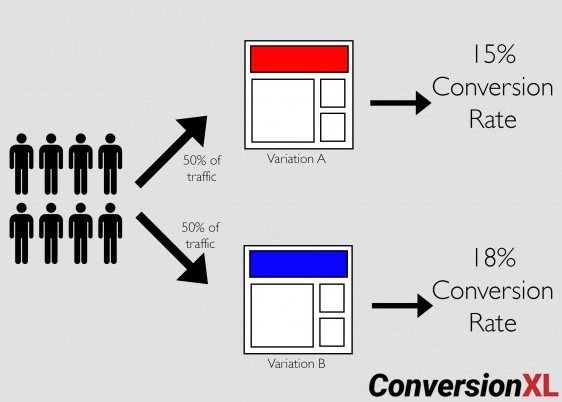
(Source – Conversion XL)
A/B testing removes guesswork from content decisions by providing data-driven insights about what resonates with your audience. This form of testing also helps maximize ROI on content investments by identifying the most effective elements, from headlines and CTAs to content structure and formatting.
Measure Content Strategy ROI
Measuring and optimizing your content strategy ROI is essential for your organization’s success. It will help you justify and maximize your content strategy and marketing investments. By understanding the relationship between your content’s costs and returns, your organization can make more informed decisions about usage and spending. Focus on measuring what matters to your business.
Conclusion
A successful B2B content strategy requires a strong audience understanding, careful planning, and consistent execution. By following the frameworks and strategies outlined above, you’ll be well-equipped to create content that resonates with your target audience and drives business growth. Remember, the key is continuously measuring, learning, and optimizing your approach based on accurate data and feedback.